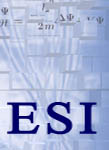at the

 Erwin Schrödinger International Institute
Erwin Schrödinger International Institute
organized by
If you want to give a talk please contact the organizers
Workshop: June 21 - 30, 2010
on D-branes, Effective Actions and
Homological Mirror Symmetry
with introductory lectures by
Conference: July 19 - 28, 2010
on Topological Strings, Modularity and
non-perturbative Physics
with introductory lectures by
The study of the topological sectors of gauge- and string theories proved to be indispensable for our understanding of the true nature of these theories, which are the basis of our understanding of particle physics and quantum gravity. In particular (non-perturbative) symmetries, which are realized as discrete automorphic groups and as integrable structures, have been discovered. They revealed dual descriptions of physical systems and lead to very concrete improvements in solving them, which are benefical to string phenomenology, black hole physics, dynamics of supersymmetric gauge theories and questions of dynamical supersymmetry breaking.
In bringing together the experts from mathematics and physics on the relevant subjects we focus particularly on three fields: 1.) Theory and application of automorphic forms, which are ubiquitous in the field. 2.) Techniques of solving the integrable structures as developed in statistical mechanics and matrix models. 3.) Application of these techniques to study non-perturbative contributions to the effective action of string- and gauge theory models.
Expected participants include(An attendance time-table can be found here)
Hatzinikitas Agapitos (Samos) Mina Aganagic (Berkeley) Marco Baumgartl (Munich) Serguei Barannikov (ENS) Alexander Belavin (Moscow) Giulio Bonelli (SISSA) Vincent Bouchard (Alberta) Ilka Brunner (Munich) Philip Candelas (Oxford) Nils Carqueville (Munich) Huai-Liang Chang (Hong Kong) Xenia de la Ossa (Oxford) Frederic Denef (Harvard) Ron Donagi (Penn) Michael Douglas (Stony Brook) Nadav Drukker (Berlin) Anamaria Font (Caracas) Thomas Grimm (Bonn) Sergei Gukov (Caltech) Manfred Herbst (Augsburg) Shinobu Hikami (Tokyo) Hans Jockers (Stanford) Amir Kashani-Poor (Amsterdam) Christoph Keller (Caltech) Johanna Knapp (Vienna) Maxim Kontsevich (IHES) Wolfgang Lerche (CERN) Jan Manschot (Rutgers) Marcos Marino (Geneva) Andrei Mironov (ITEP) Alexei Morozov (ITEP) Alim Murad (Bonn) Sameer Murthy (Paris) Bengt EW Nilsson (Chalmers) Dmitry Orlov (Steklov) Tony Pantev (UPenn) Serge E. Parkhomenko (Moscow) Sara Pasquetti (CERN) Boris Pioline (Paris) Marco Rauch (Bonn) Yongbin Ruan (Michigan) Ingo Runkel (Hamburg) Emanuel Scheidegger (Augsburg) Ricardo Schiappa (Lisbon) Karl-Georg Schlesinger (Vienna) Piotr Sulkowski (Caltech) Alessandro Tanzini (SISSA) Stefan Theisen (AEI) Yoannnis Vlasopoulos (IHES) Johannes Walcher (CERN) Peter West (London)